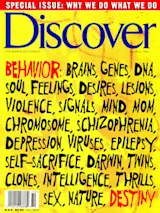Marianne Regard had never seen a case like this one. Regard, a neuropsychologist at University Hospital in Zurich, was treating a 48-year- old patient recovering from a stroke. The patient didn’t complain about the weakness in the left side of his body or his difficulty in perceiving objects in his left field of vision. What bothered him most was the hospital food. Though that’s hardly a rare gripe, the patient’s dissatisfaction was extreme. As a man who had previously shown little interest in food or dining out, he was suddenly preoccupied with eating.
Sex I start to really miss, the patient wrote in his hospital diary, and it is time for a real hearty dinner, such as a good sausage with hash browns or some spaghetti Bolognese, or risotto and a breaded cutlet, nicely decorated, or a scallop of game in cream sauce with spaetzle. Always just eat and drink! What a connoisseur I am, and now I am dried-up here, just like in the desert. Where is the next oasis? With date trees and lamb roast or couscous and mint tea, the Moroccan way, real fresh. . . . Four months later, nearly recovered from his stroke, the man quit his job as a political correspondent and started writing food columns.
Soon afterward Regard encountered a similar patient, and she realized she was onto something. This man had suffered a stroke affecting the same general area of the brain as the previous patient--the right frontal region. He, too, exhibited the same obsession with fine food. Regard assessed the next 723 patients referred to her unit for signs of gourmand syndrome--as she calls this newfound preoccupation with food and eating, particularly with food of fine quality. Of the 36 patients who fit the bill, 34 had lesions in the right frontal region of the brain, either in the cortex--the part of the brain where thought occurs--or deeper inside the brain, in the basal ganglia or the limbic system.
Eating disorders like anorexia and hyperphagia (insatiability) have been linked to lesions in the basal ganglia and the limbic system, two of the more ancient parts of the brain, but the cortex was thought not to be fundamentally involved in such a basic instinct as eating.
Despite their newfound passion for food, none of the patients became overweight. Regard estimates that perhaps 2 percent of patients with stroke-related brain lesions have gourmand syndrome--and most of them seem to be quite happy with their affliction. They say to me, ‘You know, doctor, I got a good thing out of this whole business.’














